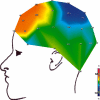Asymmetric frontal cortical activity and negative affective responses to ostracism
- PMID: 20360350
- PMCID: PMC3110424
- DOI: 10.1093/scan/nsq027
Asymmetric frontal cortical activity and negative affective responses to ostracism
Abstract
Ostracism arouses negative affect. However, little is known about variables that influence the intensity of these negative affective responses. Two studies fill this void by incorporating work on approach- and withdrawal-related emotional states and their associated cortical activations. Study 1 found that following ostracism anger related directly to relative left frontal cortical activation. Study 2 used unilateral hand contractions to manipulate frontal cortical activity prior to an ostracizing event. Right-hand contractions, compared to left-hand contractions, caused greater relative left frontal cortical activation during the hand contractions as well as ostracism. Also, right-hand contractions caused more self-reported anger in response to being ostracized. Within-condition correlations revealed patterns of associations between ostracism-induced frontal asymmetry and emotive responses to ostracism consistent with Study 1. Taken together, these results suggest that asymmetrical frontal cortical activity is related to angry responses to ostracism, with greater relative left frontal cortical activity being associated with increased anger.
Figures



Similar articles
-
On the selective relation of frontal cortical asymmetry and anger-out versus anger-control.J Pers Soc Psychol. 2004 Dec;87(6):926-39. doi: 10.1037/0022-3514.87.6.926. J Pers Soc Psychol. 2004. PMID: 15598115
-
When anger leads to rumination: induction of relative right frontal cortical activity with transcranial direct current stimulation increases anger-related rumination.Psychol Sci. 2013 Apr;24(4):475-81. doi: 10.1177/0956797612457384. Epub 2013 Feb 28. Psychol Sci. 2013. PMID: 23449843 Clinical Trial.
-
Trait anger predicts relative left frontal cortical activation to anger-inducing stimuli.Int J Psychophysiol. 2007 Nov;66(2):154-60. doi: 10.1016/j.ijpsycho.2007.03.020. Epub 2007 May 3. Int J Psychophysiol. 2007. PMID: 17561297
-
On the role of asymmetric frontal cortical activity in approach and withdrawal motivation: An updated review of the evidence.Psychophysiology. 2018 Jan;55(1). doi: 10.1111/psyp.12879. Epub 2017 Apr 29. Psychophysiology. 2018. PMID: 28459501 Review.
-
Early Career Award. Clarifying the emotive functions of asymmetrical frontal cortical activity.Psychophysiology. 2003 Nov;40(6):838-48. doi: 10.1111/1469-8986.00121. Psychophysiology. 2003. PMID: 14986837 Review.
Cited by
-
EEG asymmetry in borderline personality disorder and depression following rejection.Personal Disord. 2014 Apr;5(2):178-85. doi: 10.1037/per0000032. Epub 2013 Dec 23. Personal Disord. 2014. PMID: 24364503 Free PMC article.
-
Concurrent and prospective relations between aberrant stress-induced frontal alpha asymmetry and cannabis use disorder.Addict Neurosci. 2025 Mar;14:100195. doi: 10.1016/j.addicn.2025.100195. Epub 2025 Jan 9. Addict Neurosci. 2025. PMID: 40330273 Free PMC article.
-
When anger leads to aggression: induction of relative left frontal cortical activity with transcranial direct current stimulation increases the anger-aggression relationship.Soc Cogn Affect Neurosci. 2012 Mar;7(3):342-7. doi: 10.1093/scan/nsr012. Epub 2011 Mar 18. Soc Cogn Affect Neurosci. 2012. PMID: 21421731 Free PMC article.
-
The neural correlates of psychosocial stress: A systematic review and meta-analysis of spectral analysis EEG studies.Neurobiol Stress. 2022 Apr 26;18:100452. doi: 10.1016/j.ynstr.2022.100452. eCollection 2022 May. Neurobiol Stress. 2022. PMID: 35573807 Free PMC article. Review.
-
Serotonin transporter genotype (5-HTTLPR) and electrocortical responses indicating the sensitivity to negative emotional cues.Emotion. 2013 Dec;13(6):1173-81. doi: 10.1037/a0033997. Epub 2013 Sep 16. Emotion. 2013. PMID: 24040881 Free PMC article.
References
-
- Adolphs R. Investigating the cognitive neuroscience of social behavior. Neuropsychologia. 2003;41:119–26. - PubMed
-
- Allen JJB, Coan JA, Nazarian M. Issues and assumptions on the road from raw signals to metrics of frontal EEG asymmetry in emotion. Biological Psychology. 2004;67:183–218. - PubMed
-
- Baron RM, Kenny DA. The moderator-mediator variable distinction in social psychological research: Conceptual, strategic, and statistical considerations. Journal of Personality and Social Psychology. 1986;51:1173–82. - PubMed
-
- Basso MR, Schefft BK, Hoffmann RG. Mood-moderating effects of affect intensity on cognition: Sometimes euphoria is not beneficial and dysphoria is not detrimental. Journal of Personality and Social Psychology. 1994;66:363–68. - PubMed

